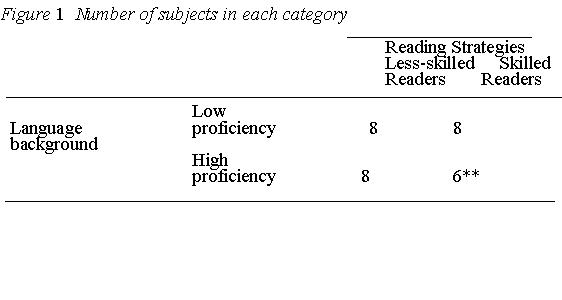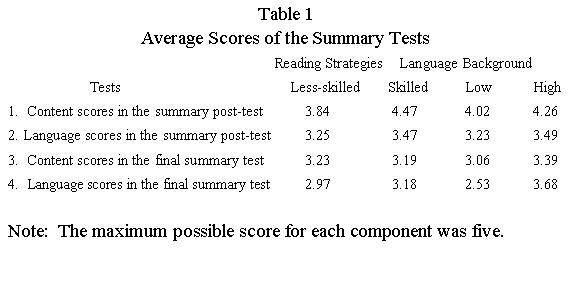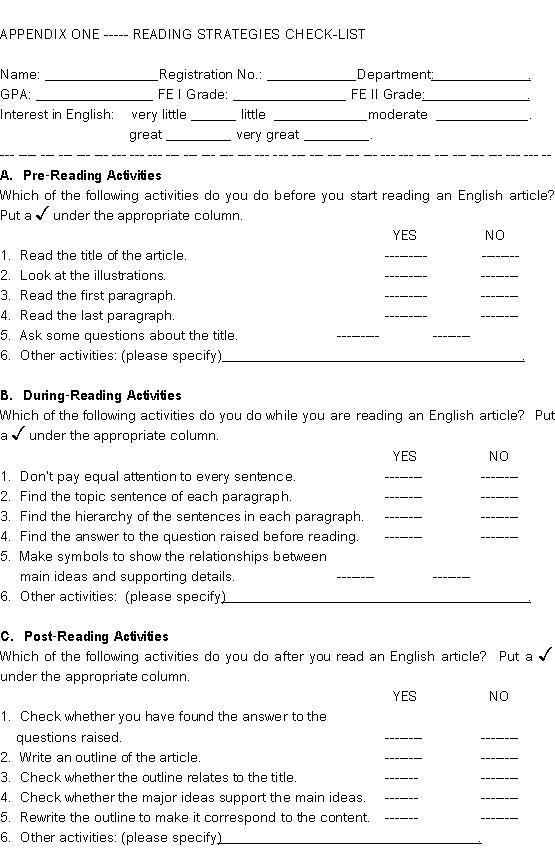
Abstract
This article examines the relationship between the reading strategies and
language background of thirty Thai science students in performing English for
Academic Purposes (EAP) summary tests. A 2*2 analysis of covariance* was
employed, with the pretest as the covariate. Although no significant
relationships were found, the data suggested that training in top-level
rhetorical organization of expository texts might enhance Thai science students’
reading comprehension. It was also noted that students proficient in
general English could transfer their language skills across content.
Introduction
Schema-based, top-down processing during reading has been a primary focus for
second language teaching in recent years because it has been considered an
important factor in reading strategies. Research on expository prose has
provided evidence that knowledge and use of textual organization can
discriminate skilled readers from less-skilled readers because comprehension is
determined not only by the local effects of sentences or paragraphs but by the
rhetorical organization of a text. Carrell (1984:89) defined a formal
schema as “background knowledge of the rhetorical structures of different
types of texts.” She also pointed out that according to the schema
theory, reading comprehension is a function of the reader’s processsing and
activating the appropriate formal and content schemata in interaction with a
text. The schema employed to comprehend a text acts like an outline which
guides the reader in organizing the text during the process of encoding into
memory. Similarly, during recall, the skilled reader activates this same
kind of superordinate schema which began the encoding and uses it to retrieve
information from stored memory about the text.
Instruction in top-level rhetorical organization of expository texts has been thought to enhance reading comprehension. Taylor and Beach (1984) and Carrell (1985) claim that reading comprehension can be significantly facilitated by explicitly teaching readers about expository text structure and by teaching various strategies for identifying and utilizing that structure during the reading process.
In the context of English for specific purposes (ESP), Hudson (1991) examined whether the emphasis on reading for content improved reading comprehension as well as knowledge of reading grammar and general reading ability in an ESP reading project. He concluded that the content comprehension approach can improve reading comprehension as well as knowledge of reading grammar and general ability to read English for science and technology among the Chemical Engineering undergraduate students at the Universided de Guadalajara in Mexico.
Although research has shown that L1 and L2 readers have benefited from formal instruction in the top-level rhetorical organization of expository texts, few studies have been reported about the transfer of skills from general English to academic English, especially in the context of teaching ESP expository prose to Thai students. This study therefore aims to answer the following research questions:
1. Do reading strategies (“formal
schemata”) and language background of Thai science students work
interdependently as predictors of performance on EAP summary tests when content
is the criterion?
2. Do reading strategies (“formal schemata”) and language
background of Thai science students work interdependently as predictors of
performance on EAP summary tests when language is the criterion?
Method
Subjects
Thirty subjects participated in this study. They were all third-year
science students enrolled in the English for Academic Purposes (EAP) Course at
the Chulalongkorn University Language Institute in 1993. Their major areas
of study were Chemistry and Chemical Engineering. The subjects were
divided into four groups based on their language background and reading
strategies. As regards language background, previous grades from the two
general FoundationEnglish Courses were used to differentiate the subjects into
low proficiency (grades C and D) and high proficiency (grades A and B).
Regarding reading strategies, a check-list of strategies for processing
top-level rhetorical organization(see Appendix One) was employed to classify the
subjects into less-skilled readers and skilled readers. The check-list was
completed at the beginning of the course. Those who scored from 60% up
were considered skilled readers while less-skilled readers were those who
scored below the passing criterion. Figure I presents the number of
subjects in each category.

The EAP Course
The study was conducted during a ten-week period from June-September 1993 in
twenty successivetwo-hour sessions during the students’ regular EAP
classes. The course covered these five units: Science News, Hi-Tech
Innovations, Energy, Problems with the Atmosphere, and Outer Space.
Reading skills and language functions included skimming and scanning;
understanding main ideas and details; guessing meaning from context; defining
and classifying; making inferences; acknowledging sources; paraphrasing;
outlining; explaining graphs, diagrams, etc; summarizing; predicting; stating
conclusions; comparing and contrasting; expressing opinions; pronoun reference;
relative clauses; sentence combination; problem and solution; cause and effect;
conditionals; and transitional devices. Although there were five units,
only the units on “Energy” and “Problems with the Atmosphere” emphaized
summary-writing skills.
Testing procedures
At the beginning of the course, the subjects were administered a pre-test (see
Appendix Two) during the class period prior to teaching in June and a post-test
(the same form) during the last class period in September. The test lasted
fifty minutes. During the final exam the subjects did another summary test
(see Appendix Three). The contents of the two tests were similar.
The pre-test was on “A Buildup of Gases” with an explicit topic sentence
whereas the final summary test was on “Ozone Depletion” with an implicit
topic sentence. The pre-test was used as the covariate in the analysis.
Scoring
All the tests were graded using the same criteria, namely, content and
language. The content component covered the topic sentence and main ideas
while the language component was evaluated for grammar and organization.
Content and language received equal weight.
Results
A 2*2 (Reading Strategies * Language Background) analysis of covariance was
conducted by SPSSPC (a powerful software package for microcomputer data
management and analysis). Table I presents average scores of the
summary tests.
Skilled readers scored higher than less-skilled readers on both the
summary post-test and the final summary test when content was used as the
criterion. As regards language background, students with high
proficiency in English outperformed those with low proficiency.
To answer the first research question ---- “Do reading strategies (‘formal
schemata’) and language background of Thai science students work
interdependently as predictors of performance on EAP summary tests when content
is the criterion?” ----- a two-way analysis of covariance was performed.
The results indicated that reading strategies and language background of Thai
science students worked independently as predictors of performance on EAP
summary post-test and EAP final summary test when content is the
criterion. The F-values were .18 and 1.07 respectively. In addition,
there was no significant difference between the mean scores of the skilled
readers and less-skilled readers. This suggests that although the students
differed in their reading strategies from the beginning, they were not
significantly different at the end of the semester. Both groups could
understand the main ideas of the texts related to their field of study.
Thus, the reading skills taught in the EAP class might benefit
less-skilled readers in comprehending EAP texts.
To answer the second research question---- “Do reading strategies (‘formal schemata’) and language background of Thai science students work interdependently as predictors of performance on EAP summary tests when language is the criterion?” ---- a two-way analysis of covariance was carried out. The results showed that the observed factors (reading strategies and language background) did not work interdependently. The F-value for the EAP summary post-test was .61 and that of the EAP final summary test was .39. It was also found that the mean scores of the students with high proficiency in general English were significantly higher than those of students with less proficiency on the EAP final summary tests (F = 14.05, p<.001). Thus, language background in general English had an effect on language performance on the EAP achievement test. The students who scored high in general English outperformed those who were less proficient.
Discussion
The fact that reading strategies (“formal schemata”) did not appear to
affect the students’ performance on the EAP summary tests when either
content or language was used as the criterion might be due to a failure of the
checklist to accurately reflect students’ reading behaviours. Also,
differences in the final summary and post-test scores may have been due to a
difference in difficulty between the two tests. Both of these factors
could affect the reliability of the instrument.

In addition, the data showed no significant relationships between reading strategies and language background. This suggests that these two components work independently rather than interdependently in an EAP course. Another intervening factor could be “technical content schema,” a term defined by Hudson (1991:86) as knowledge of content from courses that students have already taken. Technical content schema of science students may play a greater role than their language background in comprehending scientific text. In other words, less proficient students in general English might understand technical texts if they are exposed to more texts related to their field of study. However, due to the small size of the sample in the present study, further research studies using more subjects should be carried out.
When judging the students’ language performance on the EAP summary tests, language background in general English had an effect on their writing skills when language was used as the criterion. This supports Prapphal’s 1990 report that there were relationships between subskills of general English and EAP tests. It seems that all language subskills, regardless of content, are significantly related. It appears that students with high proficiency in general English could maintain their proficiency and transfer some language skills across content.
Conclusions
This study examined reading strategies of “formal schemata” and
language background as predictors of performance on EAP summary tests of thirty
third-year science students. It was found that the two factors worked
independently rather than interdependently when content and language were used
as criteria. Skilled readers and less-skilled readers did not differ
significantly in performing EAP summary tests at the end of the EAP
course. This implies that exposure to more EAP texts might enhance Thai
science students’ reading comprehension, especially for less-skilled
readers. The study also suggests that more proficient students were able
to transfer some general English language skills to academic English.
Notes
*There are two factors in the study: reading strategies and language
background. Each factor or manipulated variable consists of two
levels. The two levels of the first factor are less-skilled readers and
skilled readers and those of the second factor are low proficiency and high
proficiency in general English. In the analysis, the pre-test is used as
the covariate to make sure that the subjects are not significantly different
from the start. In order to calculate the F-value, the pre-test is
assessed first, then the factors, and lastly the interactions. If the
F-value is found to be significant, there is the relationship between the
predictor and the criterion.
**Two students from the original total of
32 were excluded from the analysis because one did not take the final summary
test due to illness, and the other did not complete the final summary test.
References
Barlett, F. C. 1932. Remembering: A Study in Experimental and Social
Psychology.
Cambridge: Cambridge University Press.
Carrell, P. L. 1984. Evidence of a
formal schema in second language comprehension.
Language Learning, 34/2: 87-112.
Carrell, P. L. 1985. Facilitating
ESL reading by teaching text structure. TESOL
Quarterly, 19/4: 727-752.
Hudson, T. 1991. A content comprehension
approach to reading English for science and
technology. TESOL Quarterly, 25/1: 77-104.
Prapphal, K. 1990. The relevance of
language testing research in the planning of language
programmes. ERIC ED 320 451.
Taylor, B. M. and Beach, R. W.
1984. The effects of text structure instruction on middle grade students’
comprehension and production of expository text. Reading Research
Quarterly, 19/2: 134-146.

APPENDIX TWO ------ THE POST-TEST
Read the following text and summarize it in your own words in about four or five sentences.
A Buildup of Gases
The greenhouse effect is caused by
a buildup of carbon dioxide and certain other gases in the Earth’s
atmosphere. These gases trap heat in much the same way that the glass of a
greenhouse does. The gases allow sunlight to pass through the air and warm
the Earth, but they don’t allow the heat to escape back into space.
Some carbon dioxide has long been present in the atmosphere. In
fact, the atmosphere’s ability to trap heat probably allowed life to develop
on Earth ---- if some of the sun’s warmth weren’t retained, the planet would
be cold and lifeless.
For at least the past 100,000 years, carbon dioxide levels were relatively
stable. Carbon dioxide is produced by animals ---- you release some every
time you exhale. It’s also released when living things decay. But
it is absorbed by plants, which use it to make food. Thus, living things
have helped to keep carbon dioxide in balance.
Now carbon dioxide levels are increasing because of people. Carbon
dioxide is produced when fossil fuels such as coal, oil, and gasoline are burned
in homes, cars, factories, and power plants. As the world’s population
has increased, so has the use of fossil fuels and so has the output of carbon
dioxide. And the carbon dioxide has accumulated in the atmosphere, forming
a kind of “blanket” around the Earth.
Other gases that contribute to the greenhouse effect --- methane, nitrous
oxide, chlorofluorocarbons (CFC’s) ----- are also being released in greater
amounts by industry and agriculture. And meanwhile, vast areas of forests
have been cleared to make room for farms and towns---destroying trees that
otherwise would help absorb carbon dioxide. In many areas, forests have
been burned away, producing even more green-house gases.
---------------------------------------------------------------------------------------------------------------------------------------------------------------------------------------------------------------------------------------------------------------------------------------------------------------------------------------------------------------------------------------------------------------------------------------------------------------------------------------------------------------------------------------------------------------------------------------------------------------------------------------------------------------------------------------------------------------------------------------------------------------------------------------------------------------------------------------------------------------------------------------------------------------------------------------------------------------------------------------------------------------------------------------------------------------------------------------------------------------------------------------------------------------------------------------------------------------------------------------------------------------------------------------------------------------------------------------------------
APPENDIX THREE ----- THE FINAL SUMMARY TEST
Read the following text.
Basically, ozone is a rare form of
the gas oxygen --- but unlike the commonly found oxygen molecules, which are
made up of two oxygen atoms linked together and denoted by the chemical symbol
02, the molecules of ozone are each formed of three oxygen atoms which are
represented by the symbol 03 --- and the gas is, volume for volume, more dense
than pure oxygen.
Oxygen and ozone in the atmosphere are closely interrelated. Oxygen
is constantly being broken down into its constituent atoms, which then link up
with other free oxygen atoms to form ozone. This in turn breaks to reform
oxygen. This formation-destruction-regeneration cycle is constantly taking
place, and the amount of ozone present at any time depends on the balance
between the forces that create it and those that destroy it.
The conversion of oxygen to ozone progresses more quickly when sunlight is
present while the reverse process, responsible for the breakdown of ozone to
free oxygen, is hastened by the presence of chlorofluorocarbons known as CFCs,
the chemicals widely used in industry. Only over the last 50 years have
human beings been producing large quantities of CFC, but concentrations of it in
the atmosphere have been increasing by about five percent each year.
What is so significant about the gas ozone, which is present in greatest
amounts in the layer of the earth’s atmosphere called the stratosphere ---
about 15 to 50 kilometres above ground level --- is this: Ozone absorbs most of
the harmful ultra-violet rays of the sun, thus preventing them from reaching the
earth’s surface. The dangerous effect on human beings of depleting the
layer of ozone in the atmosphere is due to the action of these ultra-violet rays
on our eyes and skin. Acute exposure to ultra-violet rays can cause
sunburn and temporary blindness (often termed “snow blindness”).
Exposure over prolonged periods results in skin cancers and early cataract
formation.
In 1987, an international accord signed in Montreal, Canada, called for
nations to cut their output of CFCs by 50 per cent. In June 1990, 93
countries signed a United Nations agreement to stop producing CFCs by the end of
the 1990’s. Central to this agreement was the establishment of a $240
million buffer fund to help Third World countries develop alternatives to CFCs.
Summarize the preceding text in your own words in about five sentences. Also include a topic sentence in your summary. (12 points)
-------------------------------------------------------------------------------------------------------------------------------------------------------------------------------------------------------------------------------------------------------------------------------------------------------------------------------------------------------------------------------------------------------------------------------------------------------------------------------------------------------------------------------------------------------------------------------------------------------------------------------------------------------------------------------------------------------------------------------------------------------------------------------------------------------------------------------------------------------